Hi everyone, just to let you know that you can now find a much more comprehensive view of what keeps my busy personally and professionally in the following link. All the best!
Hi everyone, just to let you know that you can now find a much more comprehensive view of what keeps my busy personally and professionally in the following link. All the best!

This 2020 brings in not just a new year, but a new decade. With it, I believe, also comes an opportunity to really be bold about what we want our future to be like and not just conform with marginal improvements. 2030 lends itself as a good target to visualize and create a vision to work towards.
It excites me to think about tech and social trends/topics to watch for moving forward. These define how our lives and societies evolve and are also deeply linked. What would something with such magnitude of social impact as the gig economy be without technology: mobile devices, payment processing, ID verification systems, etc? This new decade certainly has a lot to bring. A very interesting concept that has taken my attention is the vision of cities without cars. Not just a city with less cars, but a city without cars at all. Bold?

Picture by Andrew Kambel (edited by me)
The overall quality of life for the vast majority of people is and will be determined by the urban environment we live in. This urban environment however, has been shaped by the personal full-sized vehicle over the last decades. But now, the world’s cities are now growing at exponential rates and this model is impossible sustain. Yet, our ability to move quickly, affordably and sustainably is of fundamental importance. Visualizing a city without cars is very bold, but quite remarkable as well.
But, cities without cars? Seems impossible.
Well…Y-Combinator startup Culdesac for example, is actually building their first car-free neighborhood, launching this 2020 in Tempe, Arizona. It will be home to 1,000 people and instead of covering the neighborhood in pavement for parking and roads, more than half of the land area will be covered in landscaping, public courtyards, and greenery. Shops and entertainment will be right at your doorstep. Work in the city center? An on-site light rail stop will provide you easy access downtown. Shared, on-demand mobility through scooters and bikes will also be available. A small car-sharing lot and dedicated ride-hailing pick-up spots around the perimeter will facilitate the more tricky types of trips.
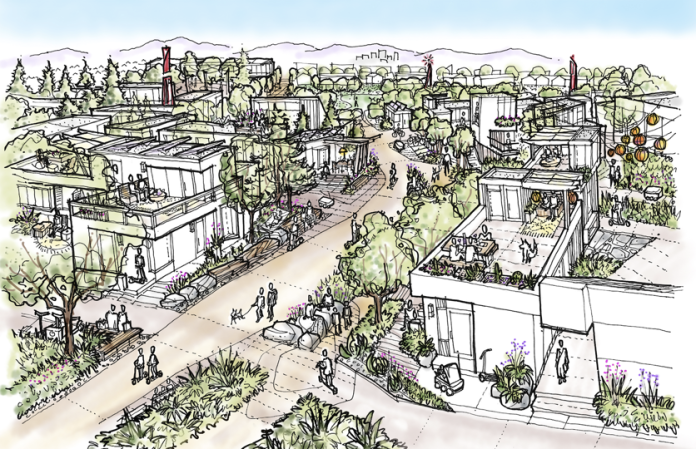
Rendering by NBBJ for Culdesac, taken from their Introduction
We can also talk about the 20-minute city/neighborhood model, where people can access their needs within a 20-minute walk, cycle or public transport trip. Cities such as Melbourne and Portland are already striving for this model, highlighting the importance of attractive and livable cities. Liveability is seen as a way to stay globally competitive, attracting more business and talent, as well as having links with general population health and environmental sustainability. A 20-minute city model translates to an area with a radius of about 5km and with a potential population catchment of 200,000+ people. It should provide a range of local activities and good accessibility to other high density nodes.
It’s time to be bold, let’s aim for cities without cars…
The trend of cities growing will continue, after all, these provide an immense set of opportunities for interaction with others, employment, entertainment, education, culture, etc. Our quality of life depends on the type of urban environment we live in. Cities under the current model of the personal vehicle will be limited in their growth or not be able to guarantee a good quality of life to their citizens, and therefore risk competitiveness with other cities. The current 1 person = 1 car model is not sustainable in the long run for growing cities, and likely not sustainable already for big cities. Meanwhile, cities without cars or striving to be car-free will benefit from lower traffic congestion levels, improved health outcomes, reduced emissions (GHGs and air pollutants), lower accident costs and greater social inclusion to name a few.

At some point during the year, London’s Regent Street is closed for cars. People can sit on picnic tables and enjoy live music, eat and drink, or walk along to shop. Photo by Abi Ismail.
What type of city would you like to live in?
It’s hard to imagine a city without cars, harder so to build one. However, the start of this new decade brings many opportunities and we could frame this as a vision to work towards. Cities around the world are already creating pedestrian-only zones, banning cars from city centers or implementing congestion charging and building dedicated lanes for alternative forms of mobility. We have an incredible range of technologies, business models and tools that are enabling a transition. Think of shared mobility – reducing our need to own a vehicle be it a bike or a car, videoconferencing – reducing our need to move across town for a work meeting or checking up on your family, electric micro-mobility – enabling us to move longer or faster without needing a car, urban farming – enabling us to get fresh ingredients and produce in our own backyard or across the corner, co-living/working – reducing the inefficient use of space, autonomous and drone deliveries – straight to our door without having to drive to the shop. These are all opening up the possibilities, and there’ll be many more to come. It isn’t easy, but it’s achievable. Let’s be bold and build the type of cities we want to live in.

The previous episode of this series discussed the current and future challenges of urban transport. This episode will focus on the issues with the current format of transport and introduce micro-mobility.
The growth of cities is happening at a very fast pace. More than half the world’s population now lives in urban areas, and this figure is expected to grow to two thirds by 2050. Urban areas are expected to grow 80% in the next 10 years. This rapid growth and higher concentration of people in cities presents an urgent need to solve transport issues around emissions, traffic congestion and cost.
Current forms of transport are not sustainable. They pollute the air we breathe, cost us valuable hours spent in traffic and account for up to a fifth of our expenditure. The overall quality of life for the vast majority of people is and will be determined by the urban environment we live in, and our ability to move quickly, affordably and sustainably is of fundamental importance. Our infrastructure is being outpaced by the growth of cities, leaving our transport systems constrained in one way or another. How then do we find something that solves our transport needs and the issues of emissions, traffic congestion and cost?
Current forms of transport are not sustainable. They pollute the air we breathe, cost us valuable hours spent in traffic and account for up to a fifth of our expenditure.
We may be able to take some learnings from the concept of “leapfrogging”, where we leapfrog development to build the systems of the future, rather than of the past. Many references have been made to this concept in telecommunications, where emerging countries have leapfrogged landlines through the mobile phone, avoiding the development of a redundant network of physical lines that countries in Europe or the US have built.
The same is happening in the energy sector, where distributed energy systems such as renewable micro-grids and even rooftop solar are powering communities and households without the need to build out large centralized power plants and their accompanying transmission networks. Interestingly however, the energy sector has taken a hybrid approach. Distributed generation is indeed reducing demand from centralized infrastructure, but in many cases, it is still connected to a distribution line and the broader electricity system.
Transportation is likely to take a similar approach. Personal vehicles could be the ‘mobile phone’ equivalent and public transport the ‘landlines’, yet personal vehicles are the ones that have been making our cities less efficient by clogging up roads, polluting the air we breathe and so on. Cars haven’t really worked for our cities, but there are other forms of mobility coming that will enable our transport systems to leapfrog. However, let’s first address the problem with cars.
The issue largely comes down to format, more specifically size. Personal vehicles occupy a lot of space in our cities and are generally occupied by a single person (around 45% of personal vehicle trips are done with a single occupant, i.e. driver only). In a restaurant or shop for example, there are typically 2m2 of area per person, yet the vehicle that person drives to get there occupies 17m2 for parking and up to 27m2 considering the driveway; cars are occupying 13x more space than what is actually needed for you to be there!
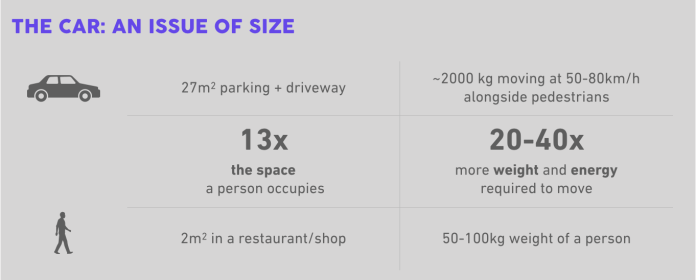
This exaggeration of size results in a waste of space and, in our roads, causes extreme traffic congestion. Because of their size, vehicles also have a lot of weight, around 2 tons of steel to be precise. There is a huge amount of energy needed to move a vehicle, roughly 20-25 times what you’d need to move yourself. And that’s without getting into the safety implications of 2 tons of steel freely moving alongside people at 50-80km/h. We have to address the issue of format; the current size of a car is the main inhibitor to the success of personal transport in cities.
This has become a very popular term recently. But what is micro-mobility?
Although many people relate the term to short distances, it more accurately relates to smaller forms of mobility, personal mobility. Renowned technology analyst Horace Dediu applied the definition: small lightweight vehicles for personal mobility, less than 500kg and for 1-2 passengers. Indeed, these vehicles tend to represent shorter distance trips but because of the nature of their size. Size, not distance, is the root of the term ‘micro-mobility’.
Micro-mobility: small lightweight vehicles for personal mobility, less than 500kg and for 1-2 passengers
There are various forms of micro-mobility currently including bicycles, electric scooters, motorcycles and hover boards, and they are evolving fast. Many more forms of micro-mobility will exist in the near future. This format of mobility presents many important benefits in contrast to the personal vehicle, principally related to space, energy, safety and cost:

A picture I took of several forms of micro-mobility – mopeds, bicycles, scooters and motorcycles – next to a car in Austin, TX. About 9 micro-mobility vehicles occupying the same space.
There is a huge potential with micro-mobility, the characteristics of these vehicles make them suitable for trips up to ~13km, representing 60% of all passenger trips and approximately 80% of trips within cities. As we continue unbundling transport and creating different forms of mobility, we will discover that there will be more than one single choice of transport and be able to choose according to the type of journey. We will truly be able to reduce our ownership of cars with a suite of mobility services and micro-mobility will play a huge role.
Micro-mobility presents an incredible opportunity to transform mobility in our cities and make them cleaner, safer and more affordable places to live and work. It will enable zero-emissions transport, allowing us to have cleaner air in our cities. It will take up less space, enabling us to have faster journeys with less traffic and more space for parks, shops, offices and more. We will be able to move freely and in a cost-effective way. Overall, it will make our cities more inviting and help set the urban environments that will be home to more and more of us on a path towards long-term sustainability.

I’ll first start by saying why I’m writing this series. In such a complex world that we have there are a great number of problems or, better put, challenges. Each of us, each city, each country with its own. Then, there are problem solvers. Most of us strive to provide solutions to some of these problems, as a doctor would when attending someone sick or as an engineer building the next bridge. Attention for these problems is generally widespread. However, there’s a set of universal challenges, ones that go beyond borders or are present in many instances. These, I’d say, are of great importance. They tend to have some form of relationship to our basic necessities: food, energy, transport, health, shelter, wellbeing. Therefore, it is important that as society we dedicate sufficient resources, talent and time in solving these. One of these is mobility.
Mobility is defined as the ability to move or be moved freely and easily. Urban mobility then, should mean we are able to move easily within the urban environment, cities. However, is this the case? Do we really have urban mobility? By 2050, it is expected that 2/3 of the global population will be living in cities and this is an irreversible trend. Cities are growing at a very fast pace, faster than its underlying infrastructure, and part of this infrastructure is our transport infrastructure.
Therefore, we are presented with an urban transport challenge. This challenge will consist of moving 7 billion people within cities to their family, friends, home and job in a practical, affordable and sustainable way. Are we doing it now? It doesn’t seem like so and we have to make a significant correction. The main challenges of urban transport in cities are emissions, traffic and costs. Some have certain elements more acute than others but those are the underlying trends. These relate to some of the necessities I mentioned above, mainly energy, transport, health and wellbeing. How are we benchmarking in terms of these problems? Below I explore these in more detail, with a particular focus for a region that is my home, Latin America.

Average measurements of PM 2.5 & 10 in Mexican cities, compared to World Health Organization (WHO) Guidelines and Mexican Official Standard (NOM). Data from the WHO Ambient Air Pollution Database 2016.

INRIX Scorecard 2018
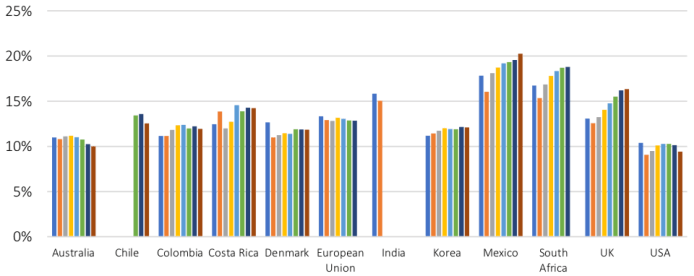
Transport Spending as a Share of Household Spending, Evolution from 2008 to 2015. Gandelman et al., 2018. Household Spending on Transport in: Latin America and the Caribbean
These indicators show that we’re already at a difficult spot. How then, will we solve this challenge moving forward? How will we ensure the cities of today and tomorrow are livable? The following of this series of three will be dedicated to what I believe to be an option for a solution, defining it and justifying how it can work.

NOTE: I’ll try to re-draft in English for other readers if I’m able to, in the meantime click on the links throughout the text for some good reads.
Imagina un lunes por la mañana: te despiertas, haces un café y te preguntas «¿Qué quiero hacer hoy?». Hoy no tienes que ir a trabajar. No porque estés de vacaciones o te hayan despedido, sino porque el mundo ahora es así. Miles de personas como tú se han levantado esa mañana en tu misma situación, y mañana será igual, y pasado, y el día después.
«¿Pero cómo? ¿Acaso nadie tiene que abrir su tienda? ¿Dónde anda el bolero de la esquina? ¿Quién va a pasar a recoger la basura? – no ves a nadie trabajando- ¿Pero cómo puede ser?». Si nadie trabaja no puede funcionar la sociedad. ¿Cierto? Se tienen que desempeñar ciertas labores para que todo funcione organizadamente. Te viene a la mente que tienes hambre y empiezas a preocuparte, «¿Quién produce mi alimento? Seguro tiene que haber algún agricultor trabajando. Sin alimentarse no puede vivir el ser humano, ¡una de nuestras necesidades básicas!», y sin embargo estas ahí, vivo.
Ese mundo puede ser éste donde vives en algunos años, y al ritmo que van las cosas puede ser más pronto de lo que nos pudiéramos imaginar. La tecnología, en especial la inteligencia artificial y automatización, están eliminando la necesidad de intervención humana en muchas actividades. En otras palabras, está reduciendo el numero de empleos que desempeñan dichas actividades.
2016 fue el año de la inteligencia artificial y automatización. Se hicieron un sinnúmero de avances que ponen a la tecnología a un paso más cerca de hacer cosas que alguna vez se entendía solo podían hacer los humanos. Piensa en los autos sin conductor de los Ubers y Googles que tanto han salido en las noticias y redes sociales, o en la fábrica de Tesla que tendrá la capacidad de operar ‘sin luz’, dado a su alto nivel de automatización. La tecnología va a remover la necesidad del ser humano en muchas labores, algunas más rápido que otras.
La tecnología desde hace tiempo tuvo fuerte impacto en la clase obrera y manufactura, sin embargo ahora puede a llegar a afectar a la clase media, la gran proporción. Quizá por esta razón ha sido uno de los enfoques principales en la Asamblea Anual del Foro Económico Mundial que se está llevando acabo esta semana en Davos, Suiza, donde los empresarios más poderosos, políticos más influyentes y académicos más reconocidos se juntan una vez al año a discutir cómo mejorar el mundo.
En cierta parte, a raíz de estos avances se crean muchos otros empleos con un grado mayor de complejidad, innovación, creatividad y por ende satisfacción personal. Sin embargo, nuestra velocidad para adaptarnos quizá no sea lo suficiente para el problema. Un reporte de la Universidad de Oxford sugiere que 47% de los empleos en EUA están en riesgo de automatización y este porcentaje es aún más alto en países con economías basadas en la industria y mano de obra, como China que tiene en riesgo el 77% de sus empleos. Se estima que 5 millones de empleos a nivel mundial dejarán de existir para el 2020.
En lo personal soy fanático de la tecnología. Creo firmemente que ésta puede resolver el 99% de los problemas que existen en el mundo. La tecnología para mí, es una de las herramientas más importantes que se le otorgó a la humanidad. Y sí, la tecnología en muchas ocasiones puede ser el problema, ni se hable de las armas de destrucción masiva, pero también la solución a muchos problemas.
Sin embargo, volvamos a ese lunes por la mañana que nos estábamos imaginando. ¿Por qué trabajamos? Mencioné que se tienen que desempeñar ciertas labores para que todo funcione organizadamente, y actualmente alguna persona las tiene que hacer. Podríamos vivir en un mundo en el que la tecnología realiza todas esas labores. Pero ¿tenemos que generar algún ingreso de alguna forma cierto? ¿Y que pasaría con ese sentido de superación, que Maslow nos indica en su jerarquía de necesidades, si no tenemos empleo?
La tecnología no es el problema, el problema es el paradigma de cómo entendemos funciona una sociedad. Hay que ser creativos, tenemos que reestructurar nuestra sociedad y el cómo se distribuye la riqueza. Aunque suene socialista, podríamos vivir en un mundo con mayor igualdad social en el cual se tiene un salario base, y donde salimos a trabajar no porque tenemos que mantenernos, sino porque queremos dedicarle el tiempo a lo que nos interesa y apasiona. Países como Finlandia lo están poniendo a experimentación. Podría ser la era de un nuevo renacimiento, el mismo estudio de Oxford indica que ocupaciones que requieren habilidades sociales y creativas serán difíciles de reemplazar. Necesitamos empezar a educar no para preparar las personas para un trabajo (que probablemente no existirá), sino para que se ‘auto-definan’ trabajo o actividades.
Incluso una reestructuración así podría tener un gran beneficio neto, emparejando la actual desigualdad social. Mejorar la calidad de vida de esa gran mayoría que vive en pobreza extrema compensaría multiples veces el hecho de que ciertas personas no serían capaces de funcionar en un sistema así, sin gran obligación o necesidad. Éste emparejamiento tendría como consecuencia un circulo virtuoso.
En el caso de México, tenemos que empezar por guiar nuestra economía hacia estos empleos que requieren mayor creatividad y razonamiento, mediante el fomento a la innovación. Si no cambiamos de enfoque, ponemos en riesgo a nuestra economía y nuestro futuro. Y en cuanto a reestructurar nuestra sociedad, siendo uno de los países con la más grave desigualdad social, a muchos no les va a gustar.
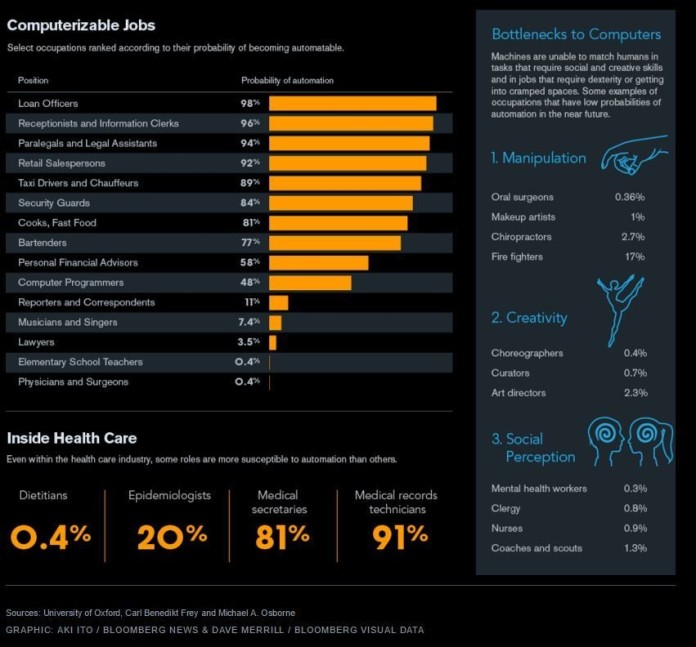
University of Oxford and Bloomberg, 2016
Today’s my first entry for this blog in English. My previous entries have been with the objective of sharing my views and all the awesome things happening in the sustainability, energy and innovation space. They’ve been in Spanish as the audience I’ve been writing for are friends, family, acquaintances, other people in Mexico and the rest of Latin America, not necessarily the people already involved in the space. Today, however, I’d like to write to a broader audience as something incredible is happening and I feel the urge to talk about it.
My previous entry back in March was about how EVs should be thought of as a thing of the ‘now’ and tried to address some of the misconceptions around them. I talked about how the cost of the batteries was coming down, about some popular models which would be available in the Mexican market, and everything about how cool this EV revolution would be. Back then, just before the Tesla 3 announcement, my evidence was mostly based on historic trends, forecasts and company goals. I wrote about it relying on my faith of how soon this would come and change our lives.
Well, a lot has happened in six months…
It really struck me last week, with a Financial Times headline that read «Ford warns tech push will hit profits». That’s a bit of a boring headline tbh (the second subheading tells the more exciting story – i’ll get to that later) but it emphasizes what I’ll call the ‘The Manufacturers’ FOMO (Fear of Missing Out)’. Something incredible is happening and these guys don’t want to miss out on it. The EV revolution is happening more fast-paced than what I and many other optimists like me expected, and I’ll put it into context through three simple elements: Ford, China and Everyone, all somehow related.

The Ford headline that week for the Companies & Markets section in the FT.
The note came from the Companies & Markets section, stating how Ford had warned profits «would fall next year as they ramp up investments in new technologies». After tossing a lot of numbers on amounts, years and percentages it read that it was due to Ford’s heavily investment in electrification of vehicles, autonomous cars and other forms of new mobility. They plan to introduce 13 electric vehicles – WOOOOW – into their line-up by 2020, forming the sub-headline which I was mostly interested about: «Electric cars expected to be 40% of line-up by 2020». 40%!!!!!!!! Pardon me for being a geek, but THAT made my day that week. If that’s not enough, they followed with how they want to be leaders in autonomous vehicles, saying it could account for up to «20% of its sales by the end of the next decade». Can you believe that? They’re even totally rethinking their business models and shifting their thoughts from selling «things» into usage (ride-sharing fleets to be explicit). Watch out Uber and Google, Detroit strikes back!…
China is thinking of imposing a quota which would require automakers to produce or import new-energy (electric, hydrogen and the such) vehicles as a proportion of the vehicles they sell. If you are looking for a number, China wants these to be sold at a rate of 3 million – again WOOOW – per year (BNEF). It seems like a simple idea, but it’s incredibly intelligent: by setting that quota they fuel their industrial economy, create technology advancements which put them in the lead globally and it gives them chance to enhance the air quality in their cities. Smart? If you think that’s hard to do, you should know they have over 200 companies/start-ups – 200!– developing electric vehicles and which are backed by several billionaires. As a matter of fact, the issue is so out of hand that China is considering restricting the number of EV makers to ten (you can read more about it here); this, to push for quality and protect the development of the industry. Not a fan of putting barriers to innovation but hey, if it works…5 year plans to go please!
Remember when you used to think of EVs and Tesla would be the one to come to mind? Well, not as simple anymore. EVERYONE, has their minds on future vehicles now. From new carmakers to old carmakers, to service platforms, to tech companies, to countries, to electricity system operators, to brothers (yes,.. brothers) are all thinking on future vehicles. Take a look at the Kreisel Bros: three brothers in Austria with a workshop developing electric-powered prototypes (land, air AND sea). The Kreisel brothers even manufacture their own battery pack, talk about these guys elbowing with Tesla! They have Austria’s first lithium-ion battery assembly plant and they’ve collaborated with partners such as VW, Audi, Airbus and Google, recently acquiring a contract under which they will build 100,000 cars over the next two years (read here). And it’s not just the electrification, it’s the greatest tech revolution in vehicles since they first began to be manufactured. As an example just this month, Uber began its trial on autonomous vehicles. They plan to ultimately replace drivers with autonomous vehicles and have taken a slightly different route than others by developing a device, and not the vehicles themselves, that is actually fitted into these. So like I said, everybody is working on the vehicle of the future. Like the saying «two heads think better than one», no bad thing can come from so much attention being focused on delivering the mobility solution of the next decade. Hopefully you can now see why manufacturers are having that ‘FOMO’, I hope I can come back again in 6 months and repeat the words «a lot has happened in six months..«.
Autos eléctricos….quizá pensemos que son cosa del mañana pero la verdad es que tenemos que empezar a pensar que son cosa del ahora. Hay muchos aspectos que tienen influencia en como se va desenvolviendo la transición hacia el transporte eléctrico: costos, limitaciones tecnológicas, disponibilidad de infraestructura, impacto ambiental, incentivos gubernamentales, etc. Hoy me enfocaré en cuatro elementos que espero les sirvan para tener un mejor panorama de los vehículos eléctricos.
Sí, quizá en la ultima década tener un auto eléctrico era similar a contar con un auto de super lujo. Uno de los primeros autos de Tesla, el Roadster, tenía un precio de más de 100 mil USD. «Yikessss!». Aunque algunos siguen siendo autos de ultra-lujo, como el BMW i8 ($137,000) o el actual Tesla S ($75,000), ya están disponibles a la venta algunos como el BMW i3, el Nissan Leaf, y el Ford Focus Electric en el rango de $30-40,000. El próximo año será uno interesante, con la llegada del tan anunciado Tesla 3 (cuál por cierto presentan por primera vez mañana 31 de Marzo) con el que la empresa propone competir en el mercado común y cual tendrá un precio de $35,o00.
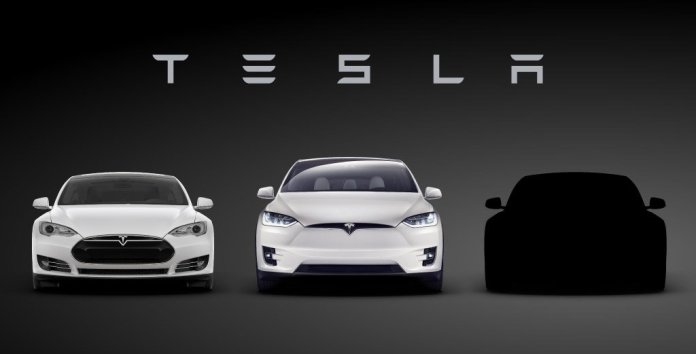
Imagen presentada en la invitación a la presentación del nuevo modelo. Fuente: Tesla
En los próximos años veremos una revolución en los vehículos eléctricos, y todo esto se debe al costo de las baterías que utilizan. Actualmente, el costo de las baterías compone aproximadamente una tercera parte del costo del vehículo. Pero «ojo», éstas están bajando de precio exponencialmente. Sólo en el último año, el costo de las baterías se redujo en 35%, lo cual significa que veremos reducciones significativas en los costos de este tipo de vehículos en los años a venir .
Para dar un poco más de contexto, las ventas de vehículos eléctricos crecieron 60% en el ultimo año. Esta es la misma taza de crecimiento que ayudo al primer automóvil, el Ford T, a vencer a las carrozas y caballos en la década de 1910. En el 2020, un poco más de 100 años después, llegará la década de los vehículos eléctricos (aunque podemos empezar desde ahora).
Existe un cierto escepticismo con los vehículos eléctricos en cuanto al alcance que tienen en las calles. A diferencia de un auto de combustible, cuando se les termina la carga se tienen que recargar y esto toma tiempo (de 30 min a 4-8 hrs dependiendo del modelo y tipo de cargador), más que recargar gasolina por supuesto. Esto causa una ‘ansiedad de alcance’ (‘range anxiety’) en el consumidor, ya que si al vehículo se le acaba la carga tomará algo de tiempo en recargar. Aquellas personas piensan que un vehículo eléctrico no les da el alcance que requieren para sus actividades día a día, pero hagamos un ejercicio:
Tomaré el ejemplo de mi trayectoria (muy activa y cual consideraba yo bastante larga) en un día regular durante mi ultimo semestre de carrera cuando vivía en Monterrey. Empiezo en mi casa por Valle Oriente, voy a clases, regreso a comer a la casa, voy a trabajar a Valle Poniente, voy al gimnasio en San Agustin, paso a visitar a mis amigos en Loma Larga y regreso a mi casa. De acuerdo a Google Maps la trayectoria es de 49 kilómetros.
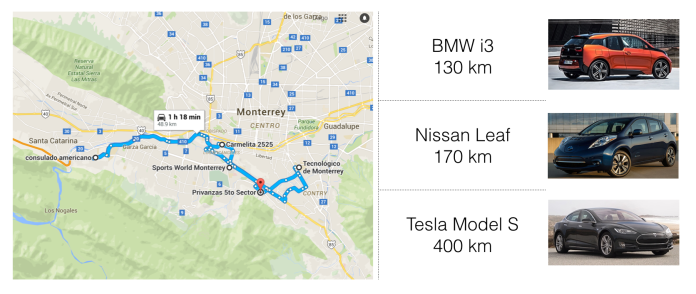
Basado en información de Google Maps y Plugin Cars
La mayoría de los vehículos eléctricos disponibles en el mercado cuentan con baterías capaces de proveer un alcance de más de 120 km, con algunos capaces de alcanzar más de 400 km en una sola carga como el Tesla Model S. A mi rutina tendría que cargar mi vehículo por lo menos cada dos días, y podría hacerlo desde el confort de mi casa al llegar a dormir en la noche y despertarme con batería llena. ¿A caso no hacemos lo mismo con nuestros teléfonos celulares?
Comprendo que habría limitaciones al tener viajes largos en carretera. Si eres una persona que requiere hacer muchos viajes largos en carretera quizá un vehículo eléctrico no sea la solución para ti. Y si es de vez en cuando que tienes que hacer un viaje así, no creo que sea tan difícil poder cambiar el auto por el día a un amigo o familiar. Sirve que quizá al usar el tuyo se convencen de comprar uno ellos mismos.
Quizá sientas que ya pagas mucho de gasolina, y con los recibos de luz como están da un poco de temor saber cuanto te va a costar recargar tu vehículo eléctrico. Sin embargo, tal vez te venga de sorpresa que cuesta más la gasolina que el equivalente en electricidad que necesitarías para tu auto.
Sin meternos mucho en los números, veamos. Si el precio de la gasolina esta a ~13 pesos por litro, sería un equivalente de ~1.5 pesos por kWh de potencial energético. La tarifa doméstica de electricidad en México es de un poco menos de un peso por kWh eléctrico. Sin embargo, para un vehículo de gasolina sólo entre 14-30% del potencial energético de la gasolina termina sirviendo para el movimiento del vehículo (debido principalmente a la ineficiencia térmica del motor) mientras que para un vehículo eléctrico esta cifra es de 74-94% (si te interesa más el análisis da click aquí).
En resumen, pagarías de 4 a 10 veces más en gasolina que lo que pagarías por la electricidad de un vehículo eléctrico de tamaño similar recorriendo el mismo trayecto. Además, hay que recordar que el vehículo eléctrico requiere menos mantenimiento de motor ya que éste es totalmente eléctrico (adiós a los cambios de aceite). Aún esta por comprobarse la degradación de las baterías y cuanto costaría su reemplazo, pero se espera que en general los gastos totales durante la vida del vehículo eléctrico sean menores que los de un vehículo convencional.
Quizá ya te estes convenciendo un poco más de los vehículos eléctricos. ¿Pero, eso es cosa de países altamente desarrollados, no? ¡Pues no! Aunque hace un año existían solo un poco más de 200 vehículos eléctricos en México a comparación de los 250,000 en Estados Unidos, esto esta empezando agilizarse poco a poco en nuestro país. Ya se están empezando a comercializar algunos modelos de vehículos eléctricos en México: Tesla por fin abrió su sitio web para ordenes en México, BMW lanzó el año pasado sus modelos i3 e i8, Nissan tiene su modelo Leaf y otros fabricantes están empezando a ofrecer este tipo de vehículos poco a poco; además también existen varias alternativas híbridas por supuesto.
Por otra parte, compañías innovadoras como Charge Now están expandiendo su red de estaciones de carga en México y por otro lado el gobierno (sí, aunque no lo crean) esta trabajando en incentivos para la adquisición y uso de los vehículos eléctricos. Por si no lo sabes, los vehículos eléctricos no pagan el Impuesto Federal del ISAN. Además, CFE tiene un programa para facilitar la instalación de un medidor independiente en tu casa para cargar tu vehículo y evitar que pases a una tarifa Doméstica de Alto Consumo. Sí, wow..

Un BMW i8 llegando a una agencia en México. Fuente: YouTube
Compañías como Uber han tenido efecto en las emisiones a nivel global sólo por el hecho de que varios de sus conductores manejan autos híbridos y/o eléctricos. El concepto de ‘car-sharing’ (del cual posiblemente platicaré más a fondo en un futuro cercano) vendrá a revolucionar la forma en la que utilizamos los vehículos y tendrá gran influencia en la adopción del vehículo eléctrico y sus emisiones. Hay mucho por venir en innovación tecnológica y modelos de negocio en este sector.
Los vehículos eléctricos vienen y para quedarse. Vale mencionar que la electrificación del transporte es necesaria para poder pasar a una economía de bajo carbono. Que tan rápido esta tome lugar tendrá influencia en que tan rápido cumplamos nuestras metas para prevenir el calentamiento global y salvaguardar nuestro futuro. Afortunadamente los vehículos eléctricos se están volviendo más económicos y se crea un circulo virtuoso; entre más vehículos se empiecen a comprar, más rápido se pueden alcanzar economías de escala y consecuentemente bajan de precio. Los vehículos eléctricos no son algo sólo del mañana, ya están a la vuelta de la esquina y tenemos que convencernos de ello…

Quizá algunos de ustedes no sepan, pero hoy inicia uno de los eventos que marcará más significativamente nuestro futuro y especialmente el de los mexicanos. Más de 150 jefes de estado y otros 50,000 participantes, incluyendo delegados oficiales de gobierno, organizaciones intergubernamentales, ONGs y sociedad civil se reunirán en Paris para la negociación más relevante de las últimas décadas. COP 21 (Conference of the Parties) o también llamada Conferencia de Cambio Climático 2015 tratará, por primera vez en 20 años, de lograr un acuerdo legal y universal sobre cambio climático. Jamás se habían reunido tantos líderes mundiales con el propósito de llegar a un acuerdo de este calibre.
¿Pero, es importante el cambio climático? México es un país que ha enfrentado muchas dificultades en los últimos años. La necesidad por resolver problemas como inseguridad, pobreza y corrupción ha desviado nuestra atención del tema y se justifica.
A algunos quizá no les importe el cambio climático, “¿existe?”. Otros hemos adoptado la cultura de que el cambio climático es un problema inminente pero no logramos apreciar el grado al que nos puede afectar. Nos hemos hecho sujetos a comentarios cómo “estará más caliente en verano, pero ay, invierno estará más a gusto!”. No logramos relacionar cómo algo tan sencillo nos podría afectar de una manera tan devastadora.
Tal vez suene exagerado pero veanlo así: el 2015 va marcando para ser el año más cálido registrado desde 1880, y por un margen revelador.
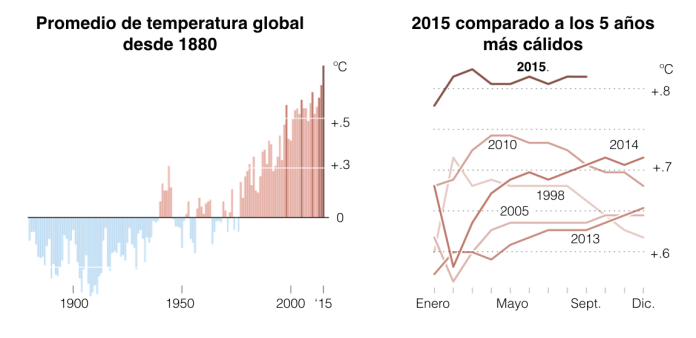
Adaptado de: New York Times
Y es que el problema no es simplemente que los días sean más calientes; con el cambio climático los días de invierno son más fríos, los desiertos son más secos, donde llueve ahora hay tormenta. Es decir, las temporada de tormentas tropicales ahora trae huracanes como Patricia, u Odile que en el 2014 devastó Los Cabos, creando pérdidas económicas en el país. Los inviernos traen consigo heladas cómo las del 2011 y 2013 que afectaron cosechas de agricultores en nuestro propio estado. En el 2011 presenciamos la mayor sequía de los últimos 70 años en el norte de Mexico, con cosechas afectadas, pérdidas de ganado y dejando una escasez de alimento en la región. Si aún sientes muy distantes los efectos del cambio climático te recuerdo la granizada de este pasado Octubre en nuestra propia ciudad, dañando cientos de vehículos, o las inundaciones tanto en Juárez como en El Paso durante la temporada de lluvia.
El cambio climático nos puede afectar en más de mil maneras (algunas aquí). Los expertos dicen que debemos mantenernos dentro de un límite de 2 grados de calentamiento global para poder estar ‘seguros’, ya que más allá de ese límite podrían desenvolverse sucesos impredecibles e irreversibles dañando severamente nuestro ecosistema. ¿Aterrador? Imagínate a México, somos simplemente una delgada división entre dos grandes océanos.
¿Y, por qué es tan importante qué todos los líderes mundiales se junten para llegar a un acuerdo? El cambio climático es un problema que a diferencia de otros NO es regional, es global. Quizá de diferentes maneras, pero nos afecta a todos. Cada país tiene que comprometerse para que con nuestro esfuerzo colaborativo no logremos rebasar el límite de calentamiento global. ¿En qué se basan estos compromisos? Ahí es donde entramos en la jugada.
El calentamiento global ocurre por varias razones pero principalmente por la emisión de gases de efecto invernadero y cambios a la superficie de la tierra como deforestación. Si me pidieras que te lo simplificara, dos de las principales razones por las que ocurre es por las emisiones de nuestros automóviles, y la quema de combustibles para producir energía (electricidad y calor). Es decir, por consecuencia de actividades que realizamos día a día.
Así pues, estos líderes mundiales estarán definiendo los compromisos que cambiarán: la manera en cómo suministramos nuestra energía, cómo nos transportamos, a dónde irán nuestros impuestos, cómo construimos nuestros edificios, cuánto pagamos de servicios, de donde vienen nuestros alimentos, entre otros más. ¿Ya empiezas a ver un poco más por qué es importante? Démosle más importancia a la negociación que marcará nuestro futuro y el mundo en el que viviremos.

La torre Eiffel de verde durante las negociaciones en COP 21. Yan Valat/ European Pressphoto Agency